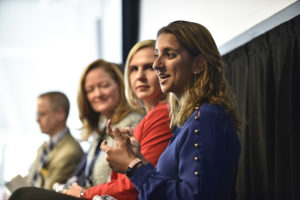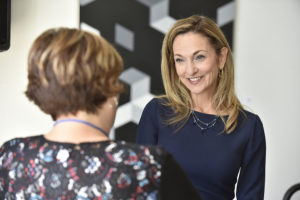What It Takes to Enhance the Whole Employee Experience


With today’s unemployment rates at record lows, many companies are competing strenuously to attract new workers—and retain the ones they have. What are their best lures? Turns out that the intangibles matter. “Large salaries and monetary perks help, but cannot offset the need for purpose and meaning,” said Naina Dhingra, a partner at McKinsey & Co., the consulting firm. “Employees want to have a clear sense of the company’s mission, how the employee can contribute to this mission, and how they can work with their co-workers to achieve the mission.”
In fact, most Americans say they would take a sizeable pay cut in order to take a job more meaningful to them, noted Albert Siu, corporate vice president for learning and development at Parexel, a biopharmaceutical company.
Yet there is no one-size-fits-all approach to keeping employees satisfied and engaged, so companies are increasingly looking at the whole employee experience. Among the elements: the right benefits to fit employees at different life stages, work schedules that offer flexibility in multiple ways, community-building efforts, and a physically healthy work environment, according to the speakers on a panel on employee experience at last month’s From Day One conference in Boston, moderated by Doug Banks, executive editor of Boston Business Journal.
Employers in recent years have been focused on one generation in particular, millennials, who now constitute the largest segment of the workforce. And they’re restless. Nearly half of them plan to leave their current jobs in two years, according to a Deloitte survey. This rate of turnover costs businesses billions of dollars. Part of the cause is that, compared to earlier generations, millennials tend to be disengaged employees, indifferent to their work and wondering if they can find a stronger sense of purpose somewhere else.

As a result, employers have a strong interest in showing workers how their efforts have an impact on the world. In the case of government workers, who may not have the same financial incentives as private-sector workers, leaders emphasize the importance of their service. “Fortunately, the majority of people who apply to work for the government choose that option because they already have a desire to serve the public,” said Dana Yonchak, senior director for talent and culture for the Commonwealth of Massachusetts.
Yonchak’s challenge is to share all of the positive things that government is doing and create a brand proposition that’s encouraging to prospective hires, especially young people who’ll make up the state’s future work force. “My team and I are working to publicize the fact that in addition to the social workers and court clerks, the doctor who is investigating the outbreak of EEE (Eastern Equine Encephalitis) is a state employee. Marine scientists who study climate change’s effect on fish and their habitats work for the state, and so on.”
In the health-care field, a sense of helping people is something workers feel directly. “They want to make a difference in our clients’ lives,” said Anastasia Bergmann, vice president of talent management, diversity, equity and Inclusion for Harvard Pilgrim Health Care. But after caring for patients, the workers need to take care of themselves, so Harvard Pilgrim takes a holistic approach to the benefits it offers employees, said Bergmann, in part by helping with the obligations in their personal lives. One is the burden of student loans; many medical professionals join the company with debts topping six figures. For call-center employees, Harvard Pilgrim added flextime and work-from-home options, which dramatically reduced rates of lateness and absenteeism.
Harvard Pilgrim also offers three volunteer days which an employee can use to visit their child’s classroom during National Poetry Month, for example, or march in support of climate change. “Our goal is to be more intentional, more strategic, with benefit packages and a-la-carte options,” Bergmann said.
The speakers reflected on the importance of healthy office environments as well. But there’s no clear consensus on what that looks like, since management thinking about office design has gone back and forth over the years. Earlier in his career, Siu worked at Hewlett-Packard, where the engineering floor was an open space because it facilitated information sharing and general communication. Then came the era of the cubicle, which put an emphasis on personal space and privacy. Now, following the example of Google and other tech firms, the open-plan office has returned, but this time around has produced a strong backlash among workers. “If you look at startups now, a lot of people wear headphones to block out noise, minimize distractions, and create a personal bubble,” said Siu.

McKinsey has recently redesigned its flagship offices in New York City and London in an effort to produce a healthy combination of those design ideas, based on the firm’s observations of employee workflow and activity, Dhingra said. In New York, the space is a combination of conference rooms, cubicles, and lounge spaces–all with lots of windows supplying natural light–and an outdoor terrace. But some organizational guidelines had to be adjusted because of how employees responded to the new design. “Team” conference rooms can be booked for a maximum of three hours, she said, because managers had noticed that teams would spend the entire day and well into the night in those rooms. Perhaps not a sustainable work pattern.
In closing, moderator Banks pointed out that “over the nearly two decades since the Journal started publishing the Best Places to Work list for Boston firms, one thing is clear. Businesses that are ranked high offer their employees more than good salaries. It’s not all about money.”
Angie Chatman is a freelance writer who covers business, technology, education and social justice. She earned her MBA from the MIT Sloan School of Management. Find her on Twitter @angiecwriter
The From Day One Newsletter is a monthly roundup of articles, features, and editorials on innovative ways for companies to forge stronger relationships with their employees, customers, and communities.